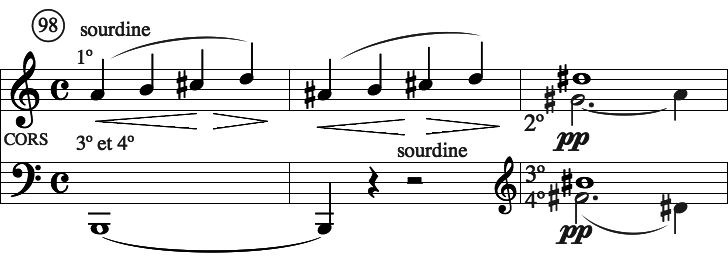3°
[English, third part]
In the score of an orchestral composition 3° will designate which musician in a section performs the indicated notes. Specifically, orchestral compositions are written for one musician to perform each part in the wind and percussion sections. As an example, if four horns are indicated in the score each horn will have a separate part to perform. Often, the composer (or editor will combine two parts onto one page of music, or in the case of the conductor's score all parts are shown on one page with more than one instrument shown per staff. If more than one part is shown on a single staff on the score there needs to be a way to indicate which part is to be performed by each performer. In the cases where both parts are performing they can be designated by placing all of the note stems up for one part and down for another. However, there are situations where only one musician is desired. In these cases, the indication 3° directs the musician on the third part to perform the indicated passage. Several indications may be used to cancel this designation, or indicate that both parts should perform a 2, à 2, a due, a deux, tutti, or unison will all effectively cancel 3°.
In the examples below (from Claude Debussy's Prelude to "The Afternoon of a Faun"), example #1 shows measure 16 of the clarinet part where the first clarinet performs alone. Measure 17 shows the notation of à 2, indicating that both clarinets perform these notes. In example #2 measure 98, the first horn performs the note in the top staff, while horn 3 and 4 perform the note in the bottom staff. In measure 100, the horns are broken into four parts with each part indicated by 1°, 2°, 3°, or 4°.
This indication would not be used in string parts. Each of the string instruments typically has multiple musicians performing on each part so the composer must use other directives. For example, if the composer wants the first violin section to perform more than one note, the term "divisi" (or divided) would used to indicated that the section would need to divide the section where some performed one note and some performed the other. Often, the first chair performers on a stand will perform the top note of the divisi and the second chair player on the stand will perform the bottom note Composers will often write more than two notes to be divided among the performers. In these cases, the principal performer in the section will determine who performs each note Again, the divisi directive is cancelled by a 2, à 2, a due, a deux, tutti, or unison.


 Example #1
Example #1 Example #2
Example #2